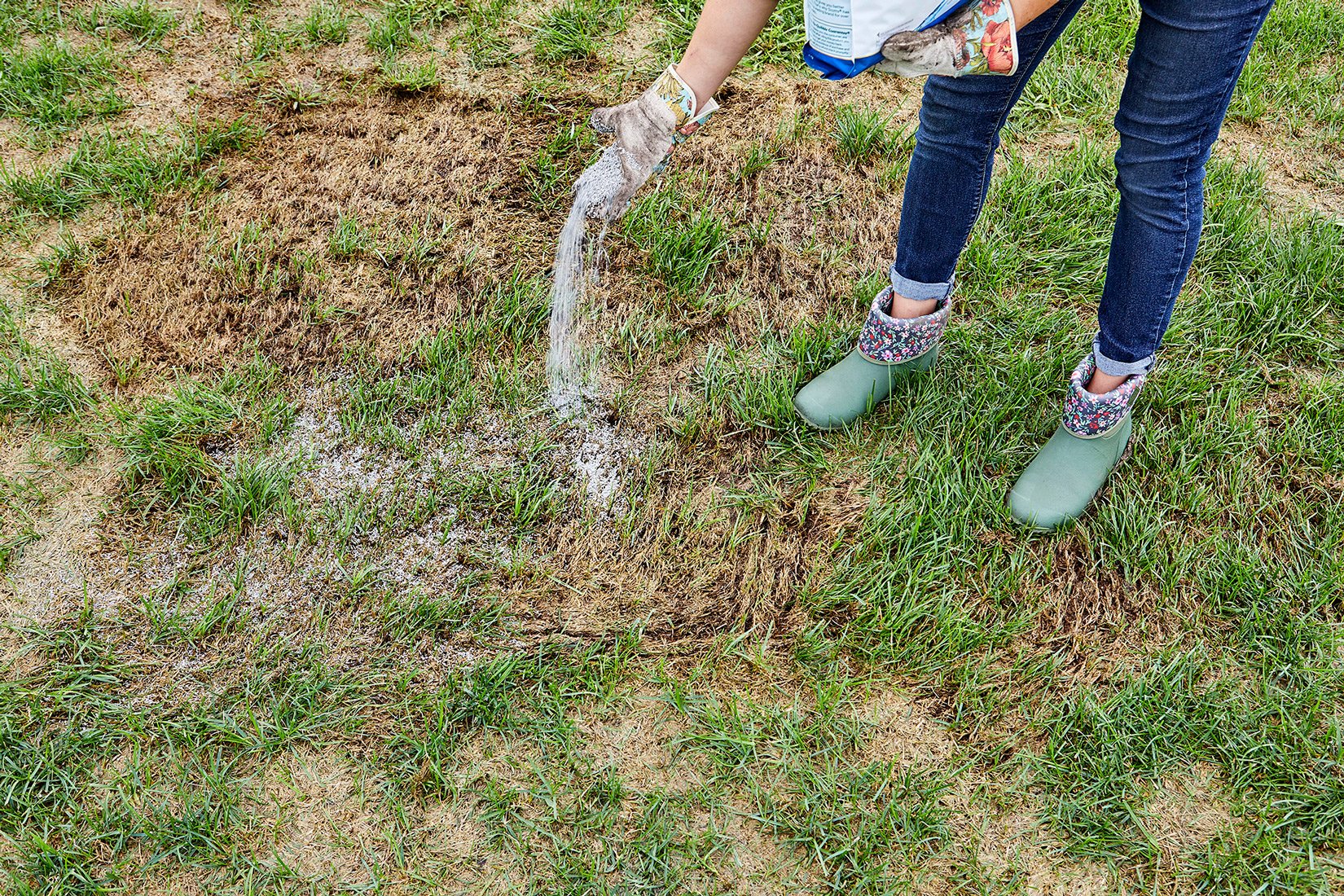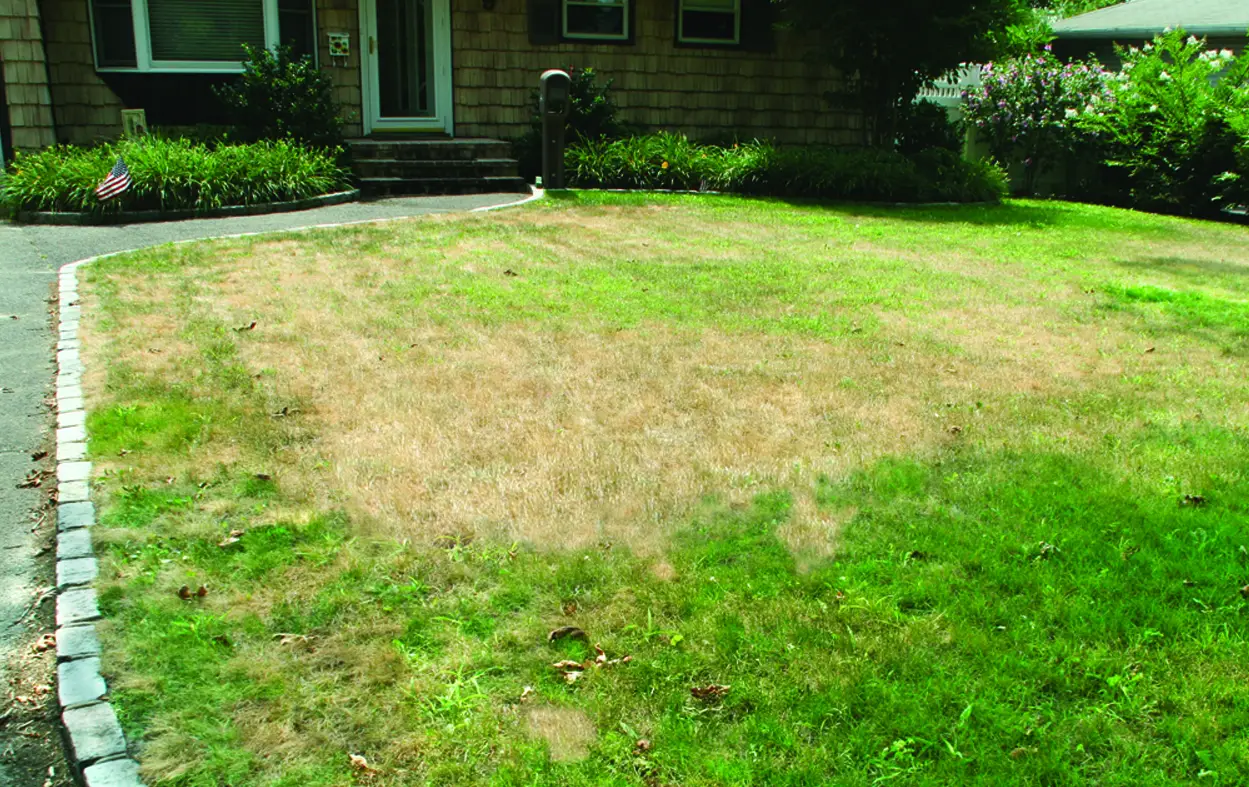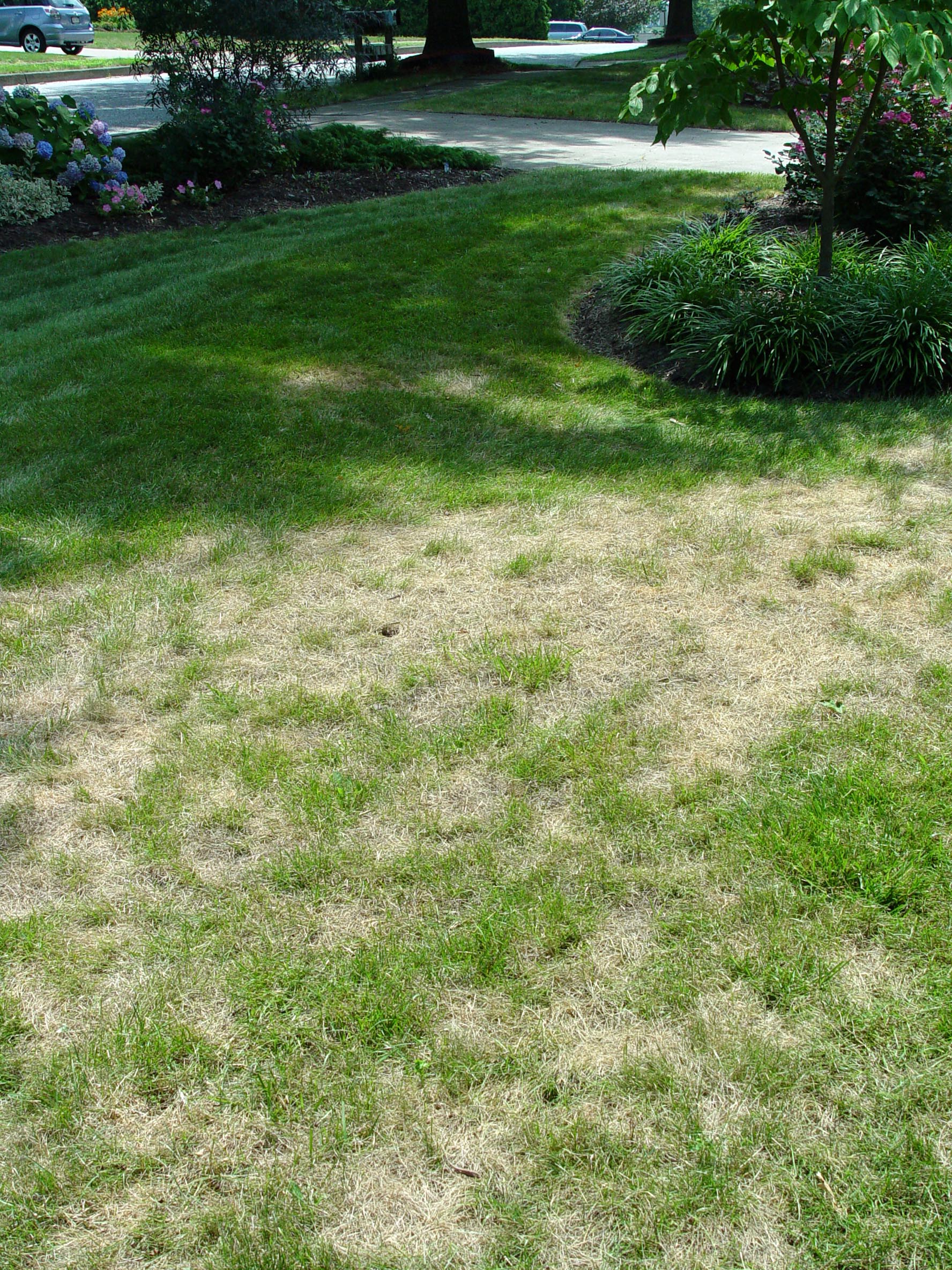What Causes Dead Spots In Bermuda Grass
When I first noticed the dead spots in my Bermuda grass, I remember they started as small circles of brown patches.
Back then, I didnt know what I know today, so I didnt think much of it at the time and just thought to water my lawn a little more since it was hot and at the peak of the growing season.
However, before I knew it, these spots had grown quite big, and I was left with ugly patches of dead grass.
To repair my Bermuda grass, I needed to find the cause, and there can be 4 of them:
When Should I Fix My Lawn Patch
If you noticed dead patches of grass in the middle of the summer, you might be tempted to go out right away and start fixing the problem.
While you could prevent severe damage, the perfect timing for fixing a lawn patch is either in autumn or spring. The weather conditions will help the grass recover quickly.
Therefore, wait for cooler weather, and then start working on getting your garden into top shape.
What Causes A Dead Lawn
A dead lawn can be caused by any number of things. It can range from dead spots in your lawn to an entire lawn of brown and lifeless grass.
Disease or drought can cause your lawn to turn from green to brown. Infestations of insects can damage your lawn.
Your clients may suffer from thatch build up, bad mowing, lack of watering, or poor fertilization.
If you are caring for a lawn, you will likely not suffer from most of the above, but a new client or one who has not used you for a while may present you with a problem.
Lets look at what can cause dead patches in a lawn or kill the entire thing.
Recommended Reading: Who Makes Mtd
Think About Aerating The Lawn
Dead patches of grass sometimes signal that it is time to aerate your lawn.
Aerating is the process of creating small holes in the ground that provide air and other essential nutrients to the soil. They go directly to the roots and can improve the overall health of your yard.
You can aerate the lawn yourself by using good lawn aerator. Keep in mind that aeration should be done once a year for most yards to prevent the soil from compacting.
How To Grow Back Grass In Dead Patches

Water grass seed in the morning because less water will evaporate.
Warning
Don’t mow the grass until it is 3 inches high. Don’t walk on new grass until it is fully grown.
It is very frustrating to plant grass, nourish it, take pride in it, then see dead patches looming before you. Once grass dies, it’s nearly impossible to get it to grow back, regardless of how much water and fertilizer you give it. To fix the lawn, you need to reseed the patches. Preparing the ground is an essential step to the success of grass seed.
Work a rototiller over the dead patches to a depth of 4 to 6 inches. Loosen up the soil and remove as much of the dead grass and weeds as possible.
Spread an inch of sand on the patches to improve drainage. Combine it with the soil with the rototiller.
Add an inch of compost on top of the other amendments. This will make the soil more fertile. Mix it in until the top inch of soil is thoroughly combined.
Apply a starter fertilizer containing a lot of phosphorus. Use the broadcast spreader to spread it evenly. Use the rate specified on the package.
Pour grass seed into a hand spreader. If the patch is large, opt for a mechanical spreader for ease of application. Walk over the patch, dispersing the seed evenly. Too many seeds create competition for nutrients and too few will leave gaps.
Run the back of a metal rake over the grass seed. Cover it with 1/8 to 1/4 inch of the soil mixture. Seed needs direct contact with soil to germinate
Related Articles
Don’t Miss: Homemade Rabbit Repellent For Lawn
The Wrong Type Of Turf
There are many different turfgrass types, and not every variety is suited for every climate and soil type. If you plant a turfy type that is incompatible with your weather or landscape, it may not last.
The first factor to check is whether your turf grass variety is recommended for your climate zone. In general, the US is divided into three growing zones for turfgrass. The northern half of the country is considered a cool-season zone and requires cool-season grass. The Southwest and Deep South are considered a warm-season zone and require warm-season varieties. The area between is regarded as a transitional zone, and lawns can be planted with either type of grass, or a combination to withstand both hot and cold temperatures. If you grow a variety of grass that is not suited for your climate, you may find your grass dying during the season it is least well-adjusted to.
Turf varieties also vary in how they handle different growing conditions. While no turf can thrive in full shade, some varieties can tolerate partial shade better than others. One of the most shade-tolerant varieties of warm-season grass is Zeon Zoysiagrass, sold exclusively by The Turfgrass Group. For lawns with trees and partial shade, Zeon Zoysiagrass will grow better than other sun-loving varieties.
How To Fix Dead Grass
Foot traffic and weather extremes like drought and flooding can damage your lawn, leading to patches of dead grass. Repair these spots now for a lush lawn spring, summer and fall.
This simple process requires just a single product, and depending upon the number of patches, not much of your time. Start with a grass seed product that combines seed, fertilizer and mulch.
Don’t Miss: Average Cost Of Trugreen
How To Repair Bare Spots In Lawns
Learning how to fix bare spots in lawn spaces is an essential part of lawn maintenance. The best method for grass spot repair is to overseed with new grass seed in the affected area. Overseeding, or planting new grass seed, allows for a healthy new start and can result in a virtually undetectable repair.
The best time to sow seeds for lawn patch repair depends on the type of grass you have. Youll want to match the type of grass seed to what is already growing. Cool season grasses do best when planted in late summer to early fall. Warm season grasses perform best when the seed is sown in spring or early summer.
If youre not sure what seed to use, give your local extension office a call. They can identify the perfect grass for your area and help figure out what types of grass will give you the quickest grass spot repair solution.
How To Fix Dog Urine Spots On Lawns
Sharing your yard with a canine companion can be one of the best parts of having a lawnuntil dog urine lawn spots and other dog damage show up in your carpet of green. By learning how to fix dog urine spots on lawns and prevent other dog-related lawn damage, you and your dog can coexist harmoniously and enjoy a beautiful, lush lawn.
Get your four-legged buddy on board and follow these basics for simple, effective dog urine grass repair:
Don’t Miss: Why Is My Lawn Brown
Do Get Connected With A Worthwhile Lawn Care Pro
If you are trying to figure out how to get dead grass to grow, then the first thing you should do is connect with a professional. Not just any professional, but a professional who really understands lawns and what they need to thrive.
Why does this matter? Because you need an accurate professional diagnosis of your lawn problem. There are so many different issues that could be causing your dead grass areas, and so many of them have similar symptoms.
It could be a lawn disease or lawn pests. It could even be an environmental stressor. But before you can start solving the problem, you need an accurate diagnosis. Its the most critical first step to a solution and if you receive an improper diagnosis and start treating the wrong problem, you can actually make the problem worse.
How To Patch The Dead Spots On Your Lawn
Summer is rough on grass. After a few straight months of heat, sun, foot traffic, and often not enough rain, its totally normal to see some dead spots. Dead grass is uglier than it is dangerous, but if youre sick of looking at it, heres a quick and dirty guide to replanting grass where its needed.
Recommended Reading: Who Makes Greenworks Lawn Mowers
Dont Just Apply More Fertilizer
Similar to watering, a lot of homeowners are inclined to throw down extra fertilizer assuming this will solve how to turn brown grass green. Actually, we find that a lot of homeowners believe the more fertilizer added to their lawn, the better.
The truth is, most summer lawn diseases are actually aggravated by too much quick release nitrogen fertilizer. If youve unknowingly hired a lawn care company that uses quick-release nitrogen fertilizer , and your lawn is struggling with turf disease, it could make it a lot worse.
The Main Causes Of Bare Spots In Your Yard

Those patchy, bare spots in your lawn are often caused by fungi, pests, compacted soil, an excess of shade or even mowing and watering habits . While reseeding helps, its worth figuring out whats causing those patches in the first place.
So, got a turf that needs to be treated? If youve eliminated fungi, bugs, grubs, pests and other causes like thatch, you may just need some seeds.
Also Check: How Much Does It Cost To Have Your Lawn Rolled
Foot Traffic Or Furniture
High wear can make it hard for your grass to grow. If your family and pets often tread the same route through your hard, this consistent traffic may create dead patches.
Leaving patio furniture, toys, or anything else on your grass for even a weekend can block sunlight and water from reaching the roots of your grass, causing dead spots. Almost anything, if left for long enough, can damage grass tarps, kiddie pools, chairs, or cars can leave behind a brown patch in their wake.
How to Prevent it
Reroute where your family and pets walk to give your grass a break. Also consider installing a stone, gravel, or mulch path where your family walks frequently.
To help grass under a trampoline stay healthy, one trick is to put a sprinkler underneath it whenever its not in use to make sure it still gets water. If youre going to put out a temporary pool, put it over a tarp first and try to move it around the yard throughout the summer so no one area gets too much damage.
Dont Just Wish For The Best
Ignoring your problem and hoping it will get better isnt going to get you anywhere. In fact, chances are, if you already have some brown and dead spots, they are only going to get worse.
These dead areas are an indicator that something is wrong and you need to take action. A problem that is causing your grass to die needs remedying.
You May Like: How To Bring Back Brown Grass
How To Fix Brown Patches In Your Lawn
Your lush green grass has been overtaken by dead brown patches and you need to know how to fix dead grass. These unsightly patches of dead spots in your lawn threaten to ruin the beautiful outdoor aesthetic of all your hot summer barbecues and events and spread disease to your grass.
Brown patches are caused by factors including, but not limited to foot traffic, lack of fertilization, fungus, grub infestation, animal urine, chemical spills, and/or drought. Dead grass patches are also more likely to occur in older lawns than younger ones.
Before you start repairing the brown patches on your lawn, study the growth patterns of these areas to see what might be contributing to the dead grass conditions. Understanding the underlying factors will help you avoid recurring brown patches in your yard.
While repairing brown patches is not particularly difficult, you should be aware of best practices and recommendations for the optimal grass regrowth. We are going to equip you with the tools and knowledge for how to fix a brown patch in your lawn through two main methods: reseeding bare spots and patching with sod.
Planting New Grass And Reviving A Dead Lawn
There are two ways of planting new grass and reviving a dead lawn. The first is to lay down seed. Use a high-quality grass seed and spread it evenly over your prepared lawn. For a larger lawn, you can rent seed spreaders from your local garden store. After the seed is laid down, cover it with a thin layer of soil.
The second method is to lay down sod. Sod is grass that is already growing and comes in rolls or squares with the roots and soil attached. To lay down sod, place it over the soil, making sure each section is set tightly against the one next to it to avoid empty patches. If you are only filling in dead spots, you can use plugs to fill in wherever you need new grass.
Whether you use seed or sod, follow up planting by rolling. Rolling sod helps press it down into the soil so the roots can attach to the ground. Rolling seed helps push the seed down into the earth so it can take root and grow strong.
Don’t Miss: When To Use Revive On Lawn In Colorado
What To Do If Your Bare Spot Is Exposed Soil
How To Fix Dead Spots On Your Lawn
Your lawn is the first impression of your home. A luscious, green plot rich with life gives off a calm energy and inviting atmosphere to all your guests and neighbors.
Bald, dead spots in your grass detract from your homes overall presentation and can interfere with the beautiful lawn every homeowner wants.
Dead spots can appear even when you follow a regimented watering and fertilizing routine. Sometimes, brown grass and dead spots are indicative of a harmless problem that can be easily remedied, like pet urine or your lawn not getting enough water.
But other times, they can be indicate a larger problem like pest infestations beneath the dirt.
The first step in treating these spots is figuring out what caused them. From pests to pets to not enough water, well help you figure out what may be causing dead spots in your lawn, how to treat them, and how to prevent them so that you can have a beautiful, inviting lawn all season long.
Don’t Miss: Does Scotts Lawn Fertilizer Expire
Preparing Bare Spots For Repair
Mow damaged spots and surrounding areas at normal spring mowing levels, and then remove dead or damaged grass to expose clean soil. If leveling is needed, add or remove topsoil, rake spots briskly, and then smooth the surface. Loose, smooth soil invites new seedlings to take hold.
Delay adding pre-emergent herbicides or weed-and-feed products to repair areas. Unless applied at least five to six weeks before seeding, these products hamper seed germination and rooting.
What Causes Bare Spots In Lawns

Bare spots in lawn areas can be caused by a number of things, and knowing how to fix patchy grass starts with identifying your lawn issues. Take the time to investigate, and try to get to the bottom of your bare spot mystery before taking the steps necessary to correct the problem. Otherwise, you may continue to repair bare spots without addressing the actual cause.
Bare spots are often the result of:
- Excessive foot traffic
- Chinch bugs and other insects
- Fungal disease
Dont worry if you cant narrow down the exact cause of the bare spots right away. Just paying attention to the location and size before you begin to repair spots can make a huge difference. If the spot returns, then continue to investigate the cause.
Recommended Reading: Where Are Cub Cadet Lawn Mowers Made
Get A Fungicide To Treat A Fungal Disease
As I mentioned before, it is best to test your grass to find out exactly what kind of fungal disease you are dealing with.
To do this, I take a 4 x 4-inch square turf sample of both the infected and uninfected grass and ensure I get the whole root as part of the sample.
Once Ive cut out my sample with a sanitized spade, I place them in an open paper bag and take it directly to my local extension for testing. If I cant take the sample immediately, I keep it refrigerated until I can get it tested.
When I have received the results, I visit my garden store so I can find the correct antifungal pesticide to treat the fungal disease Im dealing with.
While you can opt for a generic fungicide, testing and treating the specific disease is best.
I make sure to follow the directions on the fungicide label so I can get rid of the disease as soon as possible.
